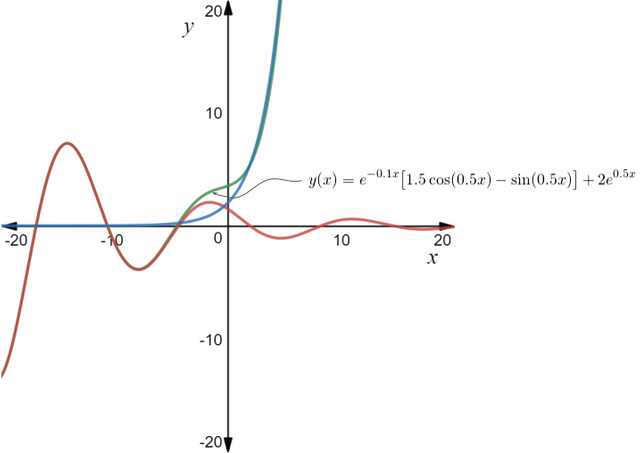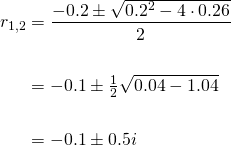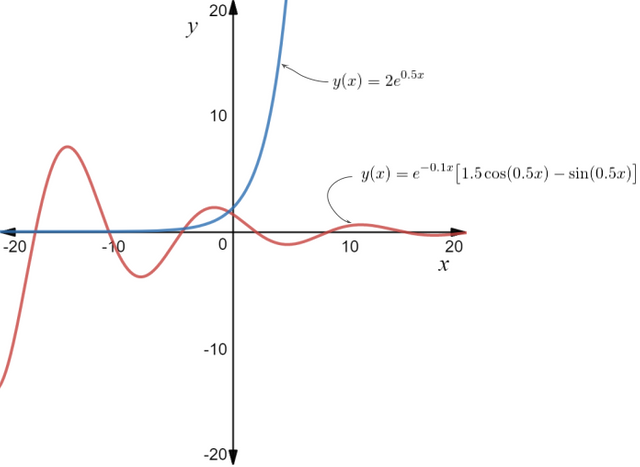Solving Non-homogeneous ODE's: Method of Undetermined Coefficients Part 2
In the last post, we went through the process of finding the solution to a 2nd order nonhomogeneous differential equation with the non-zero term r(x) as a polynomial. In this post we'll work through an example with r(x) as an exponential function.

Figure 1. The particular solution to equation (8) depicted by the green curve
Let's go straight to Example 2...
Example 2
Let's find the solution to equation (8)

with initial conditions...

Again, the first step is to find the solution to the homogeneous equation...

The characteristic equation of (9) is...

And its roots are...

Having complex conjugate roots, by equation (11) of Post #3, the solution to the homogeneous equation (9) is...

For a particular solution to the non-homogeneous equation, let's try a solution of the form...

...thus...

...and...

Now substitute the above into equation (8) ...

Therefore, the particular solution to the non-homogeneous equation is...

Now by combining (adding) the two solutions, we have the general solution...

Finally, we apply the initial conditions to equation (10) to find the particular solution to the differential equation (8)...

The first derivative of the general solution is...

...and substituting the second initial condition into the above yields...

So therefore, the particular solution to equation (8) is...

As you can see, the solution is composed of an under-damped oscillating part, and an exponential part. In Figure 2 below, we have a plot of the two separate components in maroon and blue respectively.

Figure 2. Components of the particular solution
When these are added together as shown in Figure 1 above in green, we can see that when x < 0, the particular solution is dominated by the under-damped part, and when x > 0, the solution is dominated by the exponential part.
We will go through more examples of the method of undetermined coefficients in upcoming posts.
Credits:
All equations in this tutorial were created with QuickLatex
First Order Differential Equations
- Introduction to Differential Equations - Part 1
- Differential Equations: Order and Linearity
- First-Order Differential Equations with Separable Variables - Example 1
- Separable Differential Equations - Example 2
- Modelling Exponential Growth of Bacteria with dy/dx = ky
- Modelling the Decay of Nuclear Medicine with dy/dx = -ky
- Exponential Decay: The mathematics behind your Camping Torch with dy/dx = -ky
- Mixing Salt & Water with Separable Differential Equations
- How Newton's Law of Cooling cools your Champagne
- The Logistic Model for Population Growth
- Predicting World Population Growth with the Logistic Model - Part 1
- Predicting World Population Growth with the Logistic Model - Part 2
- What's faster? Going up or Coming Down?
First order Non-linear Differential Equations
- There's a hole in my bucket! Let's turn it into a cool Math problem!
- The Calculus of Hot Chocolate Pouring!
- Foxes hunting Bunnies: Population Modelling with the Predator-Prey Equations
Second Order Differential Equations
- Introduction to Second Order Differential Equations
- Finding a Basis for solutions of Second Order ODE's
- Roots of Homogeneous Second Order ODE's and the Nature their Solutions
- Modelling with Second Order ODE's: Undamped Free Oscillations
- Modelling Car Suspension with ODE's: Damped Free Oscillations Part 1
- Modelling Car Suspension with ODE's: Damped Free Oscillations Part 2
- Modelling Car Suspension with ODE's: Damped Free Oscillations Part 3
- Non-homogeneous Differential Equations
- Solving Non-homogeneous ODE's: Method of Undetermined Coefficients Part 1
- Solving Non-homogeneous ODE's: Method of Undetermined Coefficients Part 2
Please give me an Upvote and Resteem if you have found this tutorial helpful.
Feel free to ask me any math question by commenting below and I will try to help you in future posts.
Tip me some DogeCoin: A4f3URZSWDoJCkWhVttbR3RjGHRSuLpaP3
Tip me at PayPal: https://paypal.me/MasterWu
This post has been voted on by the SteemSTEM curation team and voting trail in collaboration with @curie.
If you appreciate the work we are doing then consider voting both projects for witness by selecting stem.witness and curie!
For additional information please join us on the SteemSTEM discord and to get to know the rest of the community!